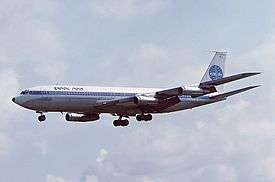Pan Am Flight 816
 Sister ship to the accident aircraft; Clipper Yankee Ranger (N418PA). | |
| Accident | |
|---|---|
| Date | July 22, 1973 |
| Summary | Crash on takeoff, cause unknown |
| Site |
Off Papeete, Tahiti, French Polynesia 17°30′56″S 149°35′10″W / 17.51556°S 149.58611°WCoordinates: 17°30′56″S 149°35′10″W / 17.51556°S 149.58611°W |
| Aircraft | |
| Aircraft type | Boeing 707-321B |
| Aircraft name | Clipper Winged Racer |
| Operator | Pan American World Airways |
| Registration | N417PA |
| Flight origin | Auckland Airport, New Zealand |
| Stopover | Fa'a'ā International Airport, Tahiti, French Polynesia |
| 1st stopover | Los Angeles International Airport, California, United States |
| Destination | San Francisco International Airport, California, United States |
| Passengers | 69 |
| Crew | 10 |
| Fatalities | 78 |
| Injuries | 1 |
| Survivors | 1 |
Pan Am Flight 816 was an international flight from Auckland, New Zealand, to San Francisco, United States, via Tahiti, French Polynesia and Los Angeles, United States. It was operated by a Pan Am Boeing 707-321B bearing the registration N417PA and named Clipper Winged Racer.[1] On July 22, 1973, at 10:06 P.M. local time, the Boeing 707 took off from Fa'a'ā International Airport in Papeete. Thirty seconds after takeoff, the airliner carrying 79 passengers and crew crashed into the sea.
Crew
The pilot was Robert M. Evarts of Grass Valley, California, a pilot who had 25,275 flight hours. He was 60 at the time of the flight. Evarts' copilot was Lyle C. Havens from Medford, Oregon, with 21,575 flight hours at the age of 60. The flight engineer was Isaac N. Lambert, of Danville, California. Lambert was flying with 9,134 flight hours when he was 38. The navigator was Frederick W. Fischer, of Rochester, New York. He was 33 at the time of the accident, with 3,961 flight hours.
Accident description
When the aircraft had reached an altitude of 300 ft (91 m), it began to descend, banking to the left. The increasingly excessive bank caused the 707 to crash into the sea and sink off Papeete.[1] Because the turn was made towards the sea at night, no visual references were available.[1] The cockpit voice recorder and flight data recorder are believed to have sunk to a depth of about 2,300 ft (700 m), and were never recovered.[1] Although no official cause was determined, it is believed that an instrument failure during a turn may have contributed to the accident.[1][2]
Neil Campbell, the sole survivor, was a Canadian citizen. At the time he said he had no memory of the actual crash, but "woke up" in the water. Many private vessels sortied from Papeete harbor that night with more joining at first light to aid in the search for survivors. The bodies of several of the flight attendants were the only ones recovered. Speculation at the time at Pan Am on the cause of the accident also considered a catastrophic windshield failure, as well as gyro horizon instrument failure. No conclusive cause was ever determined.[3]
See also
- List of sole survivors of airline accidents or incidents
- Other aircraft that crashed shortly after takeoff after pilots lost spatial orientation:
References
- 1 2 3 4 5 Accident description at the Aviation Safety Network
- ↑ "Pan Am's Accidents". PanAmAir.org. Archived from the original on 2007-12-01. Retrieved 2007-11-17.
- ↑ "Official crash report" (PDF). bea.aero (in French). May 12, 1977. Retrieved 2009-10-20.
External links
- Final accident report (Archive) (in French)